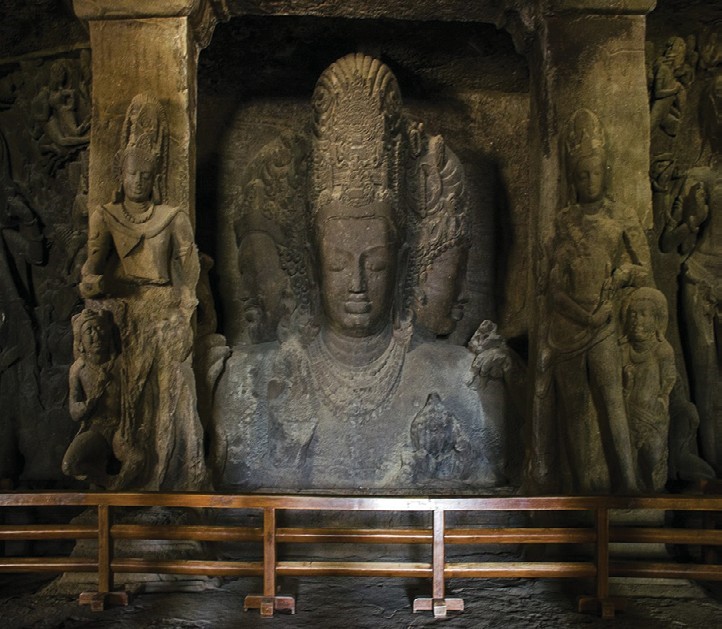Located tantalizingly close to the hustle and bustle of Mumbai, Elephanta Island is a hugely popular tourist destination listed as a UNESCO heritage site but that alone is not its stake to fame. The tourism-predominant place boasts of a treasure trove of history that reflects in the plethora of architectural marvels/ruins. Manu Shrivastava sketches the beauty of the getaway that can be accessed by a ferry.
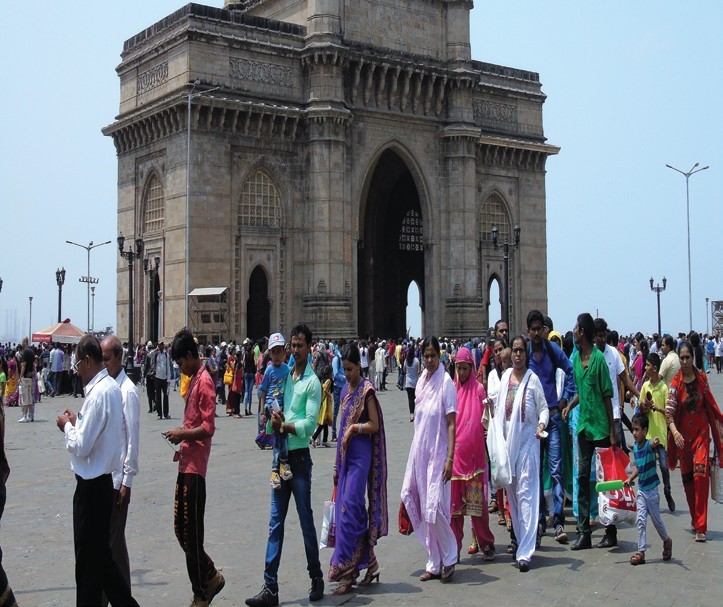 Tourists lining up at Gateway of India to board a launch to ferry them to Elephanta Island
Tourists lining up at Gateway of India to board a launch to ferry them to Elephanta Island
Located at a distance of barely ten kilometers from India’s financial capital is a quaint, hilly Elephanta Island. Accessible only through a boat ride from mainland Maharashtra, Elephanta Island aka Gharapuri is one of the most popular destinations for tourists, both domestic and foreign, visiting Mumbai.
Surrounded by the sea from all sides, Elephanta Island offers a picturesque landscape for nature lovers, a breathtaking view of Mumbai’s skyline across the waters and a unique experience, only minutes away from the hustle-bustle of India’s financial capital. The most famous attraction on the island and the one tourist’s throng to see are the Elephanta Caves which are listed as the UNESCO World Heritage Site.
Before the Covid-19 lockdown, Elephanta Island was recording more than one million footfalls every year. Elephanta Caves are on the must-visit list of most tourists visiting Mumbai. The pandemic led to a complete and total shutdown of all kinds of tourist activities on the island that affected the livelihood of many locals who were completely dependent on tourism for a living.
With the easing of the lockdown and travel guidelines, tourist activities resumed across India and Elephanta Island too began to clock in visitors. Today, once again, tourists are coming in huge numbers to enjoy a perfect get-away located only an hour away off the south-east coast of Mumbai.
Offering a unique experience
Unknown to many, Elephanta Island or Gharapuri, which lies about ten kilometers from Apollo Bunder (Gateway of India), is home to three villages with a total population of about 1,200 people. Gharapuri Gram Panchayat falls in Uran Tehsil in the Raigad district of Maharashtra and comprises three villages – namely Shetbunder, Morabunder, and Rajbunder. Shetbunder village lies in the northwest of the island, Rajbunder in the south and Morabunder in the northeast of the island.
Most islanders are dependent on tourism and related activities and belong to the Agri and Kunbi communities. The Agris are mainly found in Mumbai, Thane District, Raigad District and Palghar district in the state of Maharashtra. They are involved in fishing, salt making and rice farming. They speak the Agri dialect of Maharashtrian Konkani. In Elephanta Island, the Agris, a traditionally fishing community are now engaged in tourism and related works.
Another tribal community that is not a native of the island but its members can be seen in and around the caves is the Wadar community. Whenever there is restoration work undertaken on the island, the Wadars, a stone-carving community, live and work on the island to restore the ancient stone structures. These tribals have historically been associated with creating temple structures and cave rock carvings.
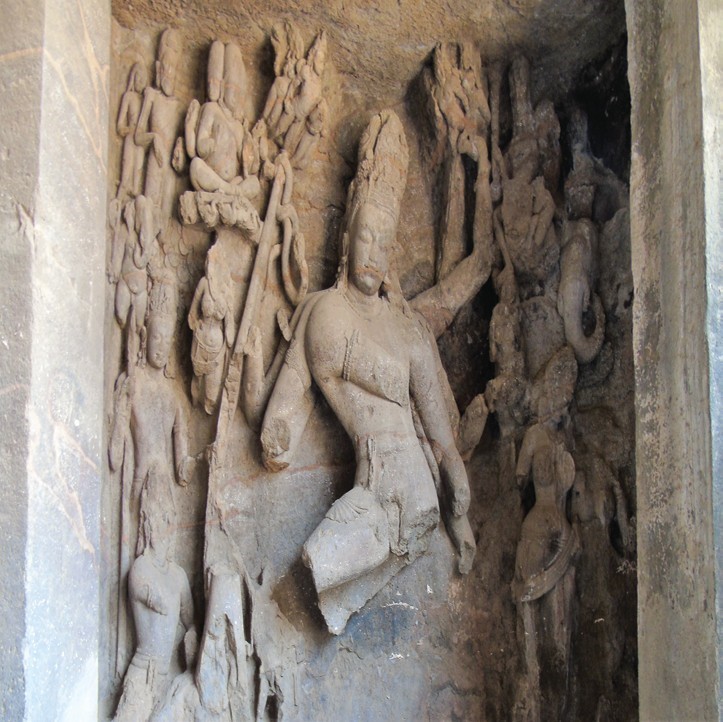 The rock sculptures at Elephanta Island lie in ruin owing to the shooting practice by the Portuguese
The rock sculptures at Elephanta Island lie in ruin owing to the shooting practice by the Portuguese
The island covers about ten sq km at high tide and about 16 sq km at low tide. The length of the island is about 2.5 kilometers. It comprises two hills with a height of about 150 meters and a narrow valley, a ravine to be specific, separating the two hills as it runs from the north to the south. The west side of the island is marked by a hill that rises from the sea and stretches east across the ravine and rises gradually to the extreme east to a height of 173 meters.
The periphery of the island is marked with sand and mangroves while the interior with a variety of trees such as tamarind, karanj, mango, palm trees, etc. Monkeys are a common sight on the island and are friendly with the tourists who can be seen feeding them corn, biscuits, etc.
 The launch that ferries tourists from Mumbai’s Gateway of
The launch that ferries tourists from Mumbai’s Gateway of
India to the Elephanta Island aka Gharapuri Island about an
hour by sea away
Elephanta Island is well connected to Mumbai through boat ferry services that ply from the Gateway of India in South Mumbai’s Colaba area. The ferry service regularly plies boats every day with a one-way ride lasting about an hour. The service is closed on Mondays which is when the caves are also closed for tourists.
Elephanta Island is also connected to mainland Maharashtra through Uran, which is where most islanders go to get groceries and other supplies, avail medical facilities, etc. Many locals who are not engaged in tourism-based activity on the island, work in the near-by town of Uran.
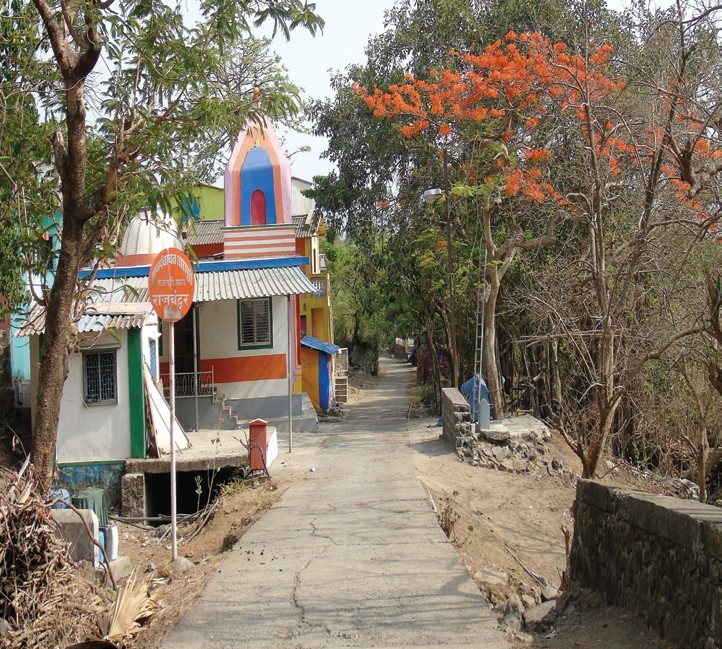 The entrance to Rajbundar Village – one of the three villages at Elephanta Island
The entrance to Rajbundar Village – one of the three villages at Elephanta Island
The rich history
Elephanta Island is known around the world for the famous Elephanta Caves. Inscribed as UNESCO World Heritage Site in 1987, the rock-cut Elephanta Caves were constructed in the mid-5th to 6th centuries AD. The small island is peppered with several other archaeological remains that speak of the rich history of the zone. The archaeological specimens recovered from the island provide evidence of human settlement dating back to as old as second century BC.
According to some experts, the island was first occupied by Hinayana Buddhists who raised a large stupa to the Buddha with seven smaller stupas around it. Coins of the Kshatrapas (Western Satraps) dating to fourth century CE were found on the island too. Some historians suggest that the caves were built by the Rashtrakutas in seventh century.
The most convincing theory of the origin of the caves on the island suggest that the caves were made between the period 450 – 750 AD that coincides with the era when Buddhism was on the decline and Brahmanical traditions were reviving in India.
Pulakesin II of the Chalukyas of Badami dynasty has been attributed with the commissioning of a significant portion of the caves. Gharapuri came under the rule of several dynasties that ruled the area. These include the Mauryas of Konkan, Trikutakas, Chalukyas of Badami, Silaharas, Rashtrakutas, Kalyani Chalukyas, Yadavas of Deogiri, Shahi dynasty of Gujarat, the Portuguese, the Marathas and also the British.
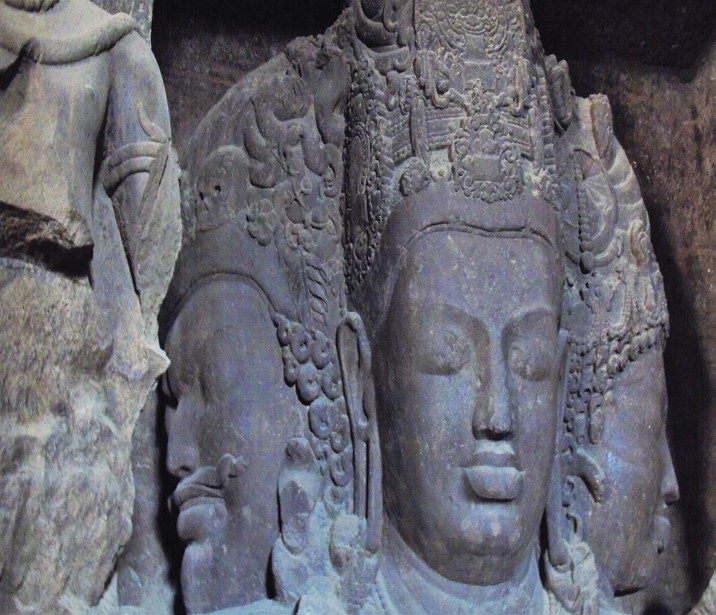 The three-headed Shiva at the Centre at the main cave in Elephanta Island , now a World Heritage Site
The three-headed Shiva at the Centre at the main cave in Elephanta Island , now a World Heritage Site
The name Gharapuri literally translates to ‘the city of caves. Elephanta Caves are a collection of cave temples predominantly dedicated to Lord Shiva. The caves and the sculptures within suffered immense damage under the Portuguese whose soldiers used the stone sculptures for target practice. The caves are presently under the protection of the Archaeological Survey of India (ASI) – responsible for the continuous maintenance and upkeep of the historic caves.
The appellation Elephanta was given to Gharapuri by the Portuguese after they discovered a huge black stone sculpture of an elephant near the old landing place. When the British took over the region from the Portuguese, the new colonisers i.e., the British tried to take the elephant to England.
In 1864, they got a crane to lift the elephant and transport it to a ship to be taken to a museum in England. The crane snapped and the priceless elephant sculpture broke into pieces. The pieces were later joined back under the supervision of the curator of the Victoria & Albert Museum of Bombay Sir George Birdwood, and today, the sculpture is housed outside Dr Bhau Daji Lad Museum at the Jijamata Udyan Zoo in Mumbai.
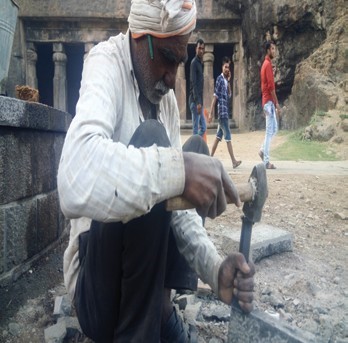 A Wadar tribal breaking stones as part of the ASI’s refurbishing works of the caves’ adjoining stone structures
A Wadar tribal breaking stones as part of the ASI’s refurbishing works of the caves’ adjoining stone structures
Most of the sculptures in the caves are damaged today but a few still remain intact. There is evidence that the caves were once painted but that most of the paintings have peeled off over time owing to the corroding effect of nature and human activity.
 The narrow strip of land from the Elephanta jetty leading to the base of the caves. A railway track to ferry tourists in a mini-train runs alongside
The narrow strip of land from the Elephanta jetty leading to the base of the caves. A railway track to ferry tourists in a mini-train runs alongside
Reaching the caves
The hour-long boat ride from Gateway of India to Elephanta Island is an experience in itself. The ferry service is shut for tourists during the monsoon months as the water gets choppy and dangerous. In the other months, the boat making its way through the vastness of the Arabian Sea overwhelms first-time visitors. If you’re visiting the island in the winter months, you may even see the migratory sea gulls that hover around the boat for the entire ride. Over-excited tourists can be seen offering food to the birds and posing for that perfect picture.
After getting off the boat on to the jetty, a long road takes you to the central square which is also the base of the hill on which the caves are located. One can either walk this distance or take a mini-train ride especially if travelling with children. The five-minute walk offers a breathtaking view of the island’s forested hills and the mangroves on the shore. Fishing boats can be seen anchored to the island or venturing into the sea for the day’s catch. One might also catch a local or two throwing a fishing net to catch fish for personal consumption.
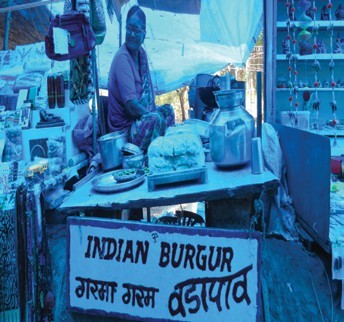 An Elephanta islander selling vada pav as Indian ‘Burgur’
An Elephanta islander selling vada pav as Indian ‘Burgur’
at a stall along the way to the caves on the Island
All along this road are locals selling all kinds of wares such as hats, umbrellas, toys, jewellery, fruits, berries, corn, etc. Upon reaching the central square or the base, one has to buy a ticket with a nominal fee to enter Gharapuri. Here, there are a few restaurants and eateries where visitors can sit and eat food or have tea and snacks.
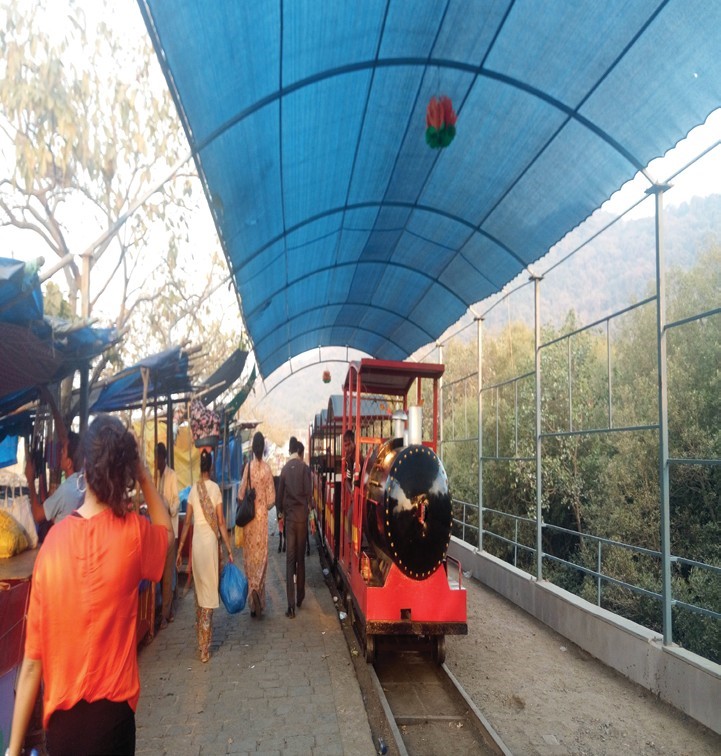 A few tourists prefer to walk along the stretch adjoining the mini train track to and fro the jetty
A few tourists prefer to walk along the stretch adjoining the mini train track to and fro the jetty
To reach the caves, one has to walk 120-odd steps from the base of the island to the top of the hill. While most tourists walk their way up to the caves, the infirm and the elderly sit in palanquins carried by locals to the top of the hill. All along the 120 steps are small shops selling rare stones, jewellery, wares, artefacts and merchandise – rare and exquisite, these items are a shopper’s paradise. Those looking to take memorabilia for friends and family, these shops offer a wide variety of options. There are a few restaurants as well along these steps where tired tourists can sit to take a bite or freshen up. The caves are a few steps away from the top of the steps.
The grandeur in stone
Elephanta Caves contain rock cut stone sculptures displaying a union of ideas of Hindu and Buddhist philosophies. The carvings, narrating events from Hindu mythology, are made from solid basalt rock. In western India, most of the cave temples are located on the Sahyadri hills as the rock formation here is conducive for intricate and fine carving.
The island has two groups of rock-cut caves. The larger group of caves, which consists of five caves on the western hill of the island, is well known for its Hindu sculptures. The primary cave, numbered as Cave 1, is about one km up a hillside facing Mumbai harbour. Caves 2 through 5 are next to Cave 1 further southeast arranged in a row. Caves 6 and 7 are about 200-meter northeast of Caves 1 and 2, but geologically on the edge of the eastern hill, also known as Stupa Hill. The western hill is called Canon Hill as it also houses the Portuguese-era firing canons. Both are connected by a walkway.
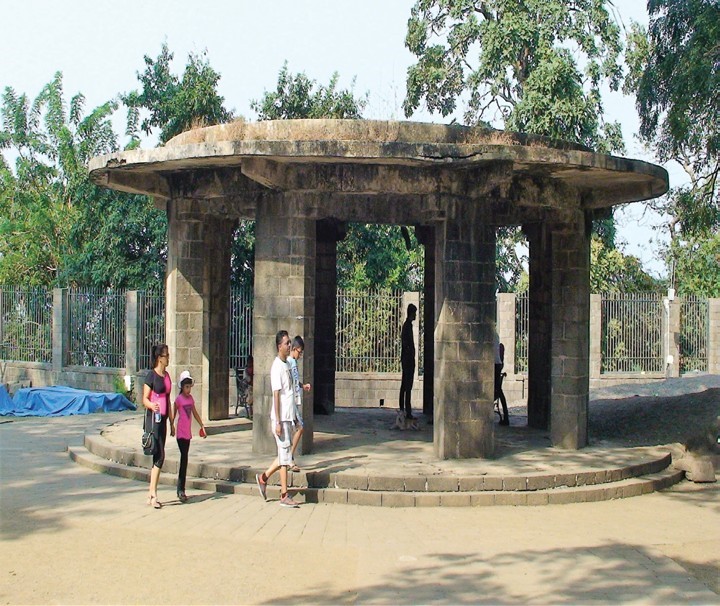 A stone structure provides shelter for tourists to take a break and shield themselves from the scorching sun and grab a snack or two while visiting the caves
A stone structure provides shelter for tourists to take a break and shield themselves from the scorching sun and grab a snack or two while visiting the caves
All the caves are rock-cut and together have an area of 5,600 sq meters or 60,000 sq ft. The most elaborate ones have a main chamber, two lateral chambers, courtyards, and subsidiary shrines.
The most important among the caves on Elephanta Island is the great Cave 1 measuring 39 meters from the front entrance to the back. This cave is very similar, in plan, with the Dumar Lena cave at Ellora. The main body of the cave, excluding the porticos on the three open sides and the back aisle, is 27 square meter in area and is supported by rows of six columns each.
The first thing that catches one’s attention in this cave is the seven-meter-high masterpiece called ‘Sadashiva’ representing the three aspects of Shiva – the Creator, the Preserver and the Destroyer. So, the masterpiece represents Aghora or Bhairava, Taptapurusha or Mahadeva (central full face) and Vamadeva or Uma.
A figure of Ardhanarisvara, a form of Shiva with male and female energy, is carved on the east panel and representations of Shiva and Parvati playing chausar are sculpted on the west panel. Andhakasuravada murti, the cosmic dance of Nataraja, Kalyanasundaram murti, Gangadhara murti, Ravana shaking Kailasa and Shiva as Lakulisa are among the other famous panels in the main cave.
The main temple’s orientation and the relative location of other temples are in a mandala pattern. The main cave (Cave 1 or the Great Cave) was a Hindu place of worship until the Portuguese arrived when the island ceased to be an active place of worship.
Maharashtra Tourism Development Corporation’s (MTDC) logo is the 20 feet high monolith of the three-headed Trimurti Sadashiva representing the three aspects of Shiva – life and creativity, a destructive force and the protector of humanity.
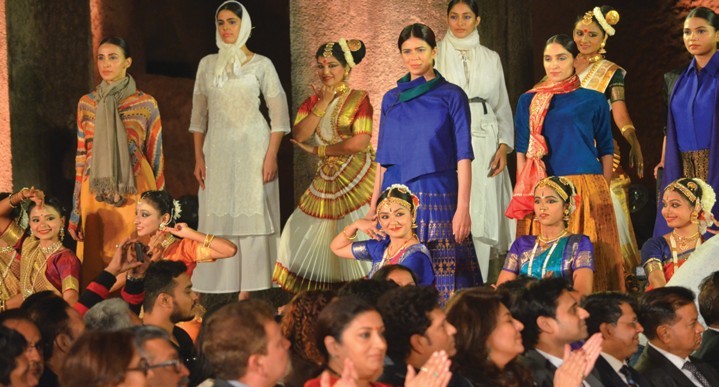 A fashion show held at an event at Elephanta Island before the COVID lockdown.
A fashion show held at an event at Elephanta Island before the COVID lockdown.
Tourism potential and preservation
The island is also famous for Elephanta Festival, a popular and celebrated festival organised by the MTDC. Held at Elephanta Island, right next to Elephanta Caves, the festival promotes tourism and culture. The festival is dedicated to the diverse classical music and dance forms of India and is celebrated in February every year.
Main events during the two-day festival include – classical dance performances, plays, skits, instrumental and vocal performances, live music, folk dance performances by local fishermen, etc.
The zone is protected primarily by the Archaeological Survey of India (ASI), which also undertakes the management of the Elephanta Caves with the assistance of other departments, including the Forest Department, Tourism Department, MMRDA, Urban Development Department, Town Planning Department and the Gram Panchayat of the Government of Maharashtra, all acting under the various legislations of the respective departments.
The ancient caves need constant care through restoration and conservation works. They need to be protected from corrosive saline waters and from nearby industrial activities too. Elephanta Island is a delicate tourist spot, not just environmentally but culturally as well. Presently, tourists can only visit the island during the day and have to leave by evening. The locals are heavily dependent on tourism for their livelihoods. A sustainable and sensible approach is the only way ahead to maintain the tourism potential of the island.

